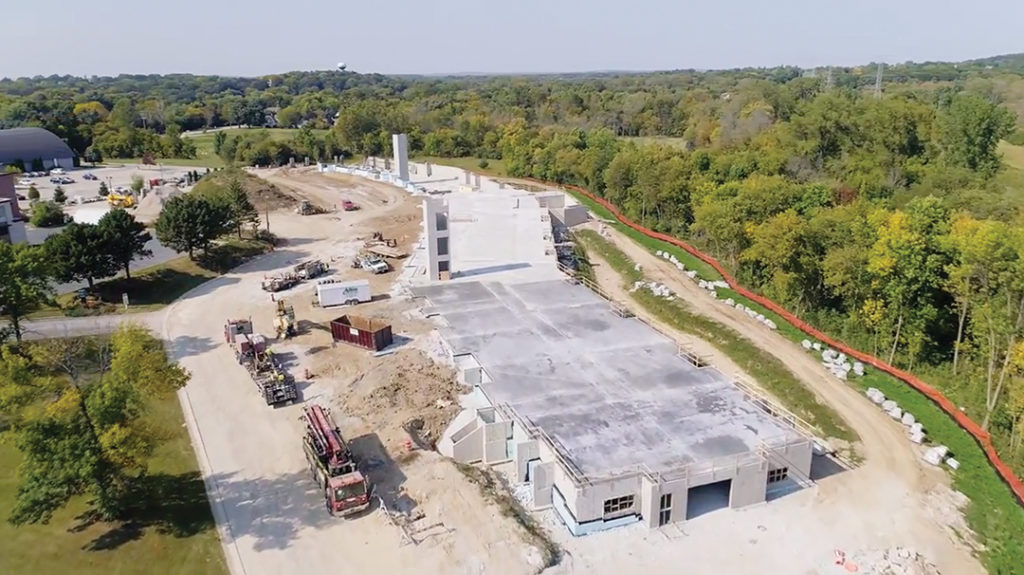THE BIGGER SIDE OF CAST-IN-PLACE
Multi-Family Foundation Structure | Poplar Creek Apartments
VAN WYKS INC., WALDO, WISCONSIN
CFA Contractor Member

A returning participant in the annual CFA Projects of the Year program, Van Wyks Inc., demonstrated the diversity of talent and proficiency found in CFA contractor members all across the country, including the sophistication of technology to create their story. Nestled into the hills near Milwaukee, Wisconsin, Poplar Creek Apartments is another example of extreme concrete foundation detailing lost in completed, complex architecture.
“This project may be the finest work we’ve had the privilege to complete,” said Matt Van Wyk, president of Van Wyks Inc. “Not only are we proud of our accomplishments and our reputation that won us the project, but the involvement of such great technology and product solutions from fellow CFA members makes this Poplar Creek project truly CFA award-worthy.”
The project is an apartment community consisting of two stunning residential buildings with underground parking interconnected by a sun-drenched, two-story, state-of-the-art community center. From a foundation perspective, the 181,000-square-foot project required 2,643 yards of concrete and more than 83 tons of steel. The footings contained over 1,000 yards of concrete and over 68,700 pounds of steel, and the walls added over 1,600 yards of concrete and more than 97,600 pounds of steel. “Prior to this project starting, we achieved and produced Riverwalk Apartments for this customer,” said Van Wyk. “There, we proved that we have the technical capabilities and knowledge to produce such a complex array of walls and overcome difficult foundation challenges in a timely fashion with high quality.”
The project’s complexity was evident as soon as Van Wyk started receiving the plans. The walls contained double mats of structural steel. They were detailed with continuous step ledging at varying heights with tight tolerances to support the first-floor steel and precast concrete flooring members. While maintaining focus on the technical details and quality, the team was challenged by the heights of the walls. “At 15 feet in height these walls asked a lot of our forming system,” offered Van Wyk. “But the safety aspects for fall protection forced us to re-write our planning and adjust to the weekly OSHA site inspections. Our i’s were dotted, and our t’s were crossed the entire time.”

Often in commercial foundation construction the hole is given to the contractor and work is started on the concrete. At Poplar Creek, Van Wyks found a site that had to be over excavated and then brought back up 4 feet with ¾ inch traffic bond and pryamat. Once the base was prepared, the team began laying out the footings with Leica Total Stations, using more than 35 stationed points from surrounding buildings to achieve and maintain the ¼-inch tolerances. As the project progressed, the front entry where the buildings intersect was constructed, having an 11-foot-tall by 18-inch-thick wall on a 13-foot radius. Then, in the rear of the building at the pool area, another radius wall was constructed. It was 15 feet tall with step ledging along the entire length for the stone masonry that would later be added.
Van Wyk added that this was a team approach to making this project possible. “The suppliers and technology consultants helped us accomplish this project. Schmitz Redi Mix was a true partner producing a combination of five different mix designs and keeping curing times in check with water stabilizers and macro fibers for floor construction. Secondly, we benefitted greatly from our relationship with a CFA consulting member, Scott Carter, as we continued to have setup complications with so many control points. Finally, a CFA associate member, Pure Asphalt, was instrumental in making a solution for the cold joint waterproofing. Likewise, we have learned to apply so many technical solutions through our participation in the CFA network and were able to employ concrete pumps, conveyors, laser screeds, power buggies, riding trowels, rebar tie guns, robotic total stations, and so much more.”









